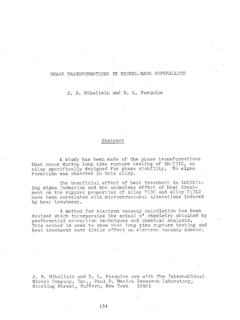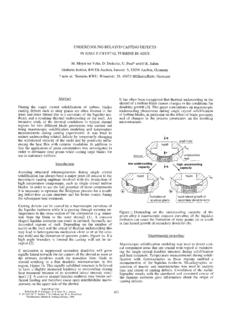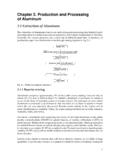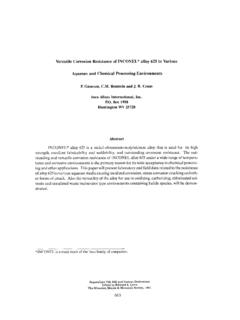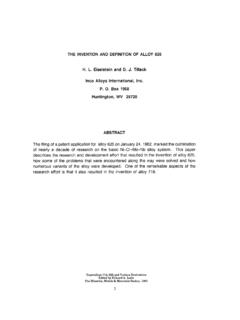Transcription of MAR M 247 Derivations - CM 247 LC DS Alloy and CMSX …
1 MAR M 247 Derivations - CM 247 LC DS Alloy CMSX SINGLE CRYSTAL ALLOYS PROPERTIES & PERFORMANCE K. Harris, Erickson and Schwer Cannon-Muskegon Corporation P-0. Box 506 Muskegon, Michigan 49443 USA Summary CM 247 LC is a chemistry modified superalloy derived in late 1978 from the MAR M 247 composition, specifically designed for directionally solidified (DS) blade and vane applications. The modified Alloy demonstrates exceptional resistance to grain boundary cracking during DS casting, advanced complex cored, thin wall airfoils, combined with improved carbide microstructure, carbide stability and ductility relative to the parent, MAR M 247. Solution heat treatment studies undertaken on DS cast material show the capability of solution treating up to relatively high 1250 C (2282 F) conditions, thereby maximizing solutioning of the y with attendant improvements in creep-strength.
2 DS castability and mechanical property data (stress-rupture, tensile and fatigue) are presented. A series of complementary single crystal (SX) alloys, developed commencing in mid-1979 from the MAR M 247 composition, provide high creep strength, good SX castability, practical solution heat treatment ranges which assist in optimizing microstructure, high y solvus temperatures and good Alloy stability. These alloys individually designated CMSX-2, CMSX-3 and CMSX-4 are also designed to have excellent high temperature bare oxidation resistance and coating performance. Environmental and mechanical property studies (both static and cyclic) are reported. Initial turbine engine test data is reported, in relation to environmental response.
3 Introduction MAR M 247 is a nickel-base, vacuum melted, cast superalloy with a high Y [Ni3 (Al, Ti..>] volume fraction (62%) and high refractory element (Ta + W + MO) content ( wt. %> . The nominal composition is shown in Fig. 1. The Alloy , developed in the very early 1970 s by Danesi, Lund and others at Martin Metals Corporation, demonstrates high creep strength and good castability along with excellent oxidation resist- ance resulting in increasing application in turbine engines. The Alloy , as originally developed for conventionally cast equiaxed turbine blade and vane parts, is not optimized for DS casting technology. DS component casting technology (1, 2, 3, 18), pioneered by Pratt & Whitney Aircraft and developed to achieve significant increases in creep strength/temperature capability, thermal fatigue properties and component durability, is seeing increasing application in modern turbine 221 engines.))
4 Aside from the addition of Hf MAR-&i-247* (4, 5) (developed by Martin Metals) to nickel- NOMINAL COMPOSITION base cast superalloys to initially assist (wt. X) intermediate temperature ductility of equiaxed castings and later DS castability in terms C Al of reducing grain boundary cracking problems, Cr Ti little emphasis is placed on Alloy development co Hf specifically for DS part applications. An W B exception is the development of Rene 150 MO Zr Alloy (6). Continuing improvements to airfoil Ta Ni Balance cooling techniques result in significant lbs/cu. in. gains in gas turbine operating efficiencies. ( gms/cc) These cooling techniques usually result Figure 1.
5 In very complex cored, thin wall [.020" ( mm) - .040" (1 mm)] airfoil designs, which are susceptible to grain boundary cracking during DS casting high creep strength alloys, partic- ularly with modern high thermal gradient casting processes. CM 247 LC, developed from the MAR M 247 base composition at the request of a turbine engine company (Ack. 1) during 1978, is intended to eliminate the DS grain boundary cracking problem. The advent of single crystal technology is not likely, in the intermediate term, to remove the need for DS airfoil components. DS airfoils will continue to be used for vane segments, second and low pressure stage blades in advanced turbine engines because of cost effective considerations.
6 Single crystal superalloy and component casting technology (7, 81, pioneered by Pratt & Whitney Aircraft, achieves further significant in- creases in creep strength/temperature capability and component durability. However, little Alloy development emphasis is evident in terms of component producibility, particularly single crystal Alloy castability and solution heat treatment, with some of the initial alloys developed. The low Ta/high W ratio alloys are found to be "freckle" sensitive (Ack. 2 and Ack. 3), particularly when cast into larger parts with lower thermal gradient casting processes. NASAIR Alloy 3 (Ref. 8>, which contains a deliberate Hf addition to improve coated oxidation/corrosion resistance, is characterized by a very narrow solution heat treatment range [ll"C (20 F)].))
7 Commercial producibility of these components is an important factor. The second generation oxidation resistant single crystal superalloys (7, 9) being introduced as turbine blade and airfoil materials show a 25OC (45'F) to 50 C (gOoF) temperature capability improvement, in terms of time to 1% creep, compared to the long used DS MAR M 200 Hf Alloy . The creep property improvement, which increases with increasing temperature/ decreasing stress, is based on optimized single crystal microstructures with full solutioning of the as-cast coarse y'. The ability to attain the fully solutioned microstructures containing 65-68 volume % of re-precip- itated fine, coherent y' with an average size of microns or less, to maximize creep response, depends upon the Alloy 's solution heat treat- ment range (difference between the y' solvus and incipient melting tempera- tures), the cooling rate from the solution temperature (8) and also response to new aging treatments (10).
8 CMSX-2 and CMSX-3 single crystal superalloys are derivatives of the MAR M 247 composition and demonstrate an attractive combination of proper- ties for advanced technology turbine blade and vane airfoil components. CMSX-4 is a third generation, ultra high strength single crystal superalloy developed for small gas turbines. This range of complementary single crystal superalloys is designed for high temperature, oxidation environment turbine applications. 222 CM 247 LC DS Chemistry Modifications The addition of Hf to high strength cast superalloys is used to combat DS grain boundary cracking problems, with levels of 2% and greater being common. Increasing levels of Hf, unfortunately, increase component rejec- tion rate and quality assurance problems due to the occurrence of HfO inclusions in the DS components usually resulting from Hf/ceramic core/shell reactions.
9 Zr and Si are known, in general, to be "bad actors" with respect to DS grain boundary cracking [small amounts of a Hf rich eutectic phase containing high concentrations of Zr and Si found in DS crack prone tests (13)l. It is also now apparent that very small reductions in Zr and Ti contents, combined with very tight control of Si and S, dramatically reduce the DS grain boundary cracking tendency of a high creep strength superalloy such as MAR M 247. The major microstructural effect of the lower Ti content in CM 247 LC, compared to MAR M 247, is to significantly reduce the size of they/y' eutectic nodules, as noted in (141, and also to lower the volume fraction of the eutectic from approximately 4% in MAR M 247 to 3% in CM 247 LC DS components.)]
10 This factor is also believed to be signifi- cant in reducing the DS grain boundary cracking tendency of CM 247 LC. The chemistry modifications incorporated in CM 247 LC Alloy are based on CM practical experience with grain boundary cracking problems in DS alloys, the use of the inductively coupled plasma (ICP) analytical technique for very accurate determination of Zr chemistry at low levels, and on earlier published CM work on MAR M 247 Alloy (11, 12). The chemistry changes and objectives are summarized as follows: Table I. Lower Zr Lower Ti Tightly Si > control S MAR M 247 .03% .lO% max 150 ppm max Lower C MAR M 247 CM 247 LC - Improve carbide .15% .07% microstructure, carbide stabil- ity and RT to intermediate temperature ductility.
